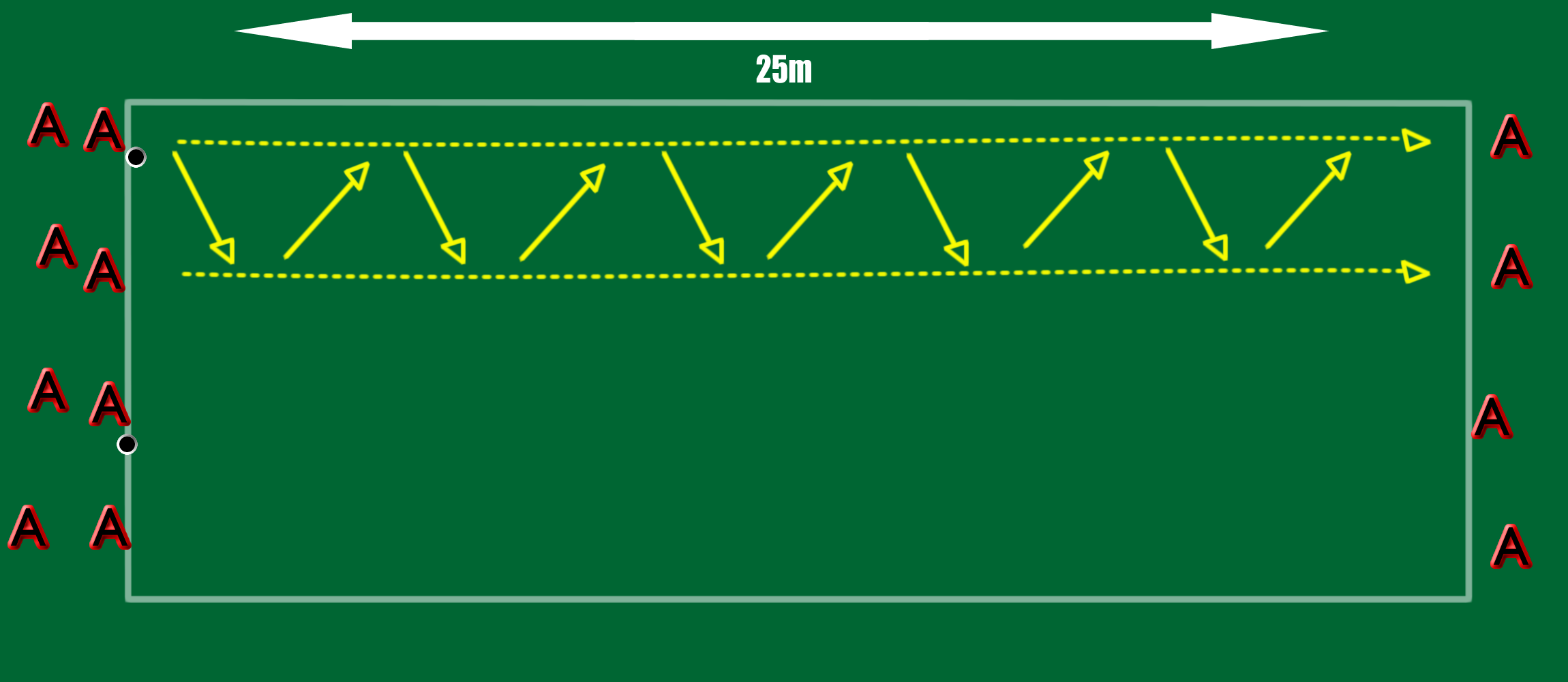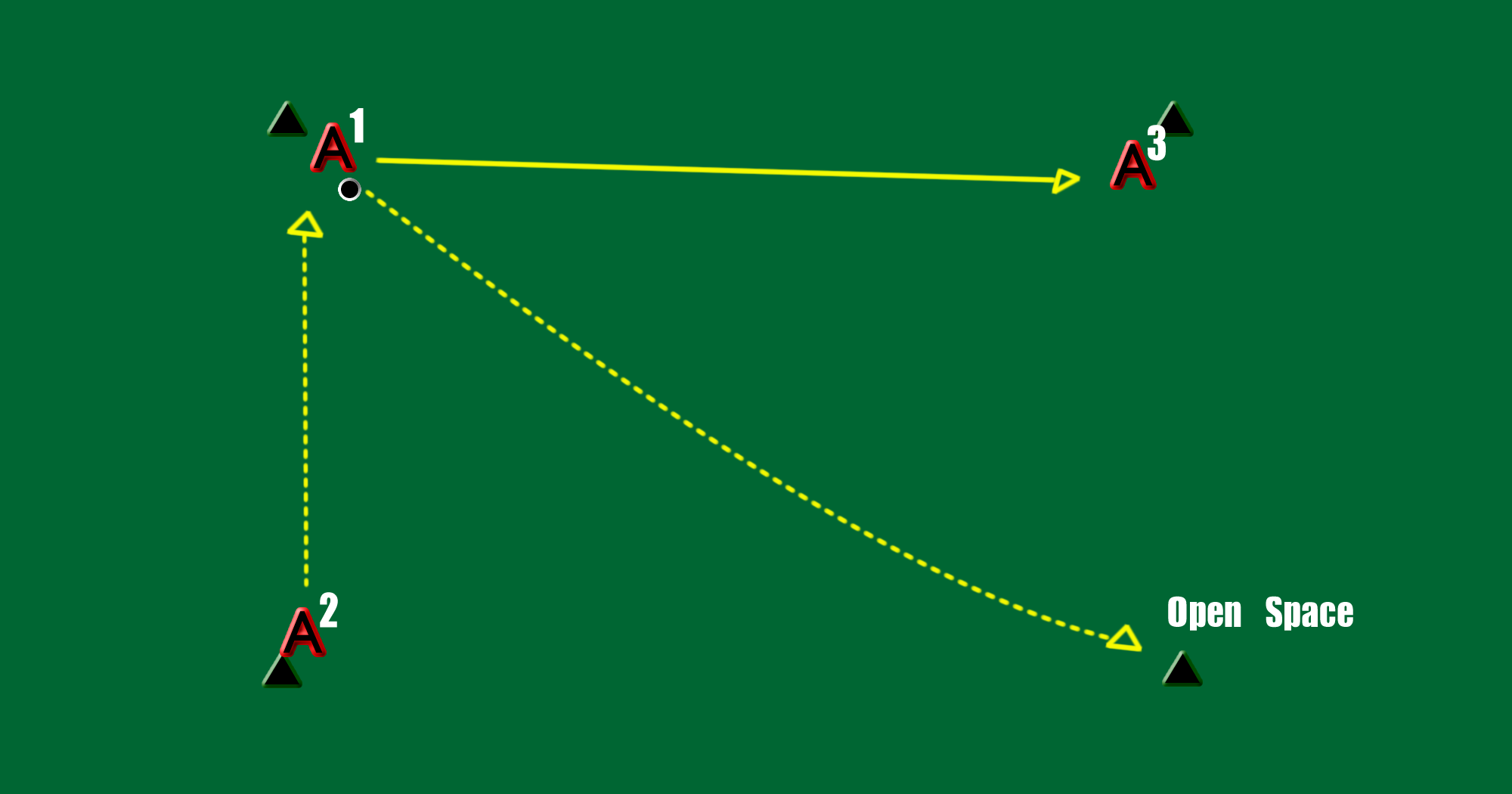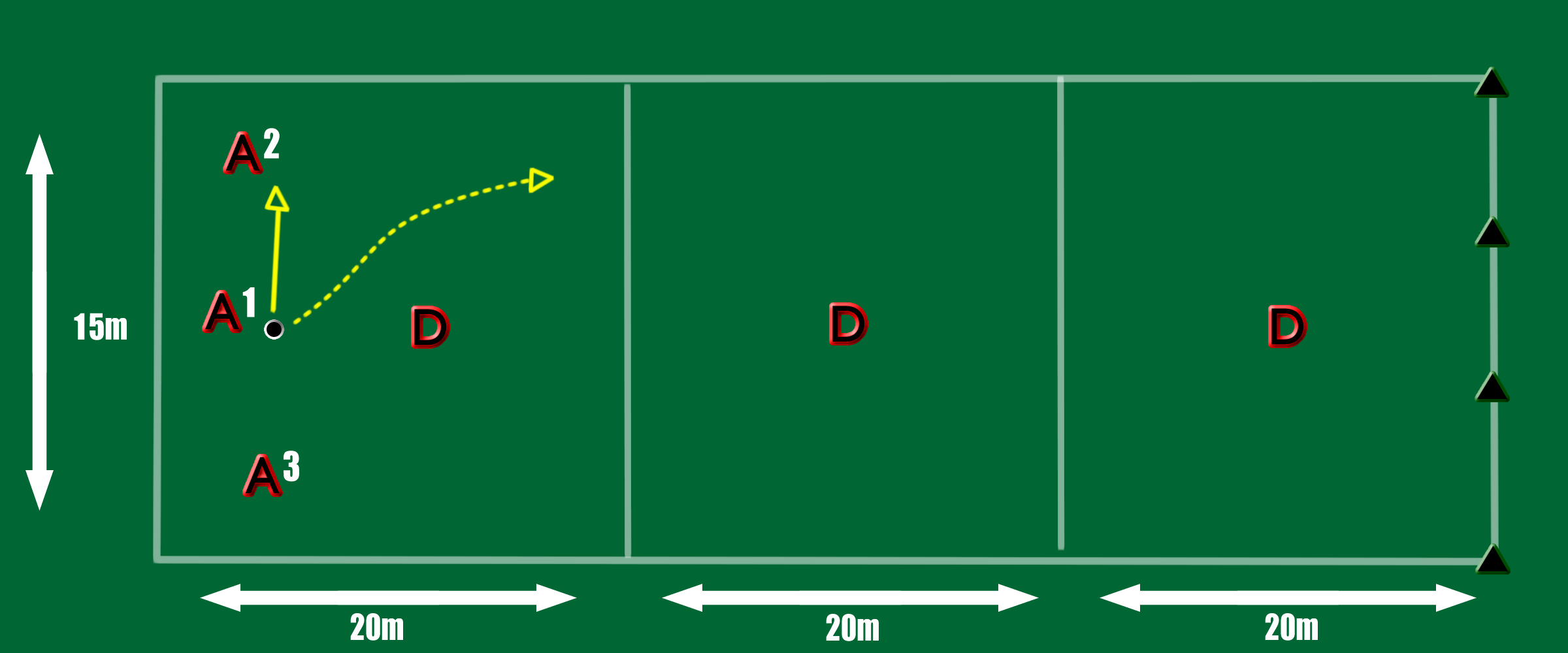FUNSTIX - Lesson 9
FMS: sprint, locomotor movements, changing direction, agility,
TECHNICAL: Review Passing and Receiving.
TACTICAL; Moving to Open Space-Where To Move; Passing -Where to Pass
FMS: sprint, locomotor movements, changing direction, agility,
TECHNICAL: Review Passing and Receiving.
TACTICAL; Moving to Open Space-Where To Move; Passing -Where to Pass
Activity 1
i) 5 minutes Snakes Assign players in lines of 3 to five equal size players, with 5 yards between each player. Players move in and around a 25 yard square going in a variety of directions, following the first person in the line who chooses the locomotor movements that the other must follow. The last person in each line sprints in and out of the other players in their line and assumes the role of the leader.
ii 6 minutes Diagonal Hop Scotch. DIAGRAM In threes, each group with 6 cones. One after the other, each player takes a turn performing the footwork sequence as described in the diagram.
Activity 2
8 minutes Shuttle Passing Players are placed in shuttle formation 10 yards apart( there should be an even number of shuttle lines and no more than 4 players per line). Each even numbered shuttle line has one ball; the first players in each pair of lines use square passes to move to the other end of a 25 yard playing area passing the ball back and forth to each to each other using correct technique for passing and receiving the ball to the left and the right.

Activity 3:
i) 8 minutes Around the Square * Players should perform this activity first without the ball and stick. In assigned groups of 3 players of equal skill, each player stands beside 1 cone in a 4 cone, 10 yard square. One player has ball. The other 2 players must stand on the 2 cones closest to the player with the ball. THIS RULE MUST BE ENFORCED THROUGHOUT THE ENTIRE ACTIVITY. The player with the ball passes to either of the other 2 players and then runs to the free cone (open space). The player who was not passed to, moves to the cone vacated by the passer. This sequence is continuously repeated. Players pass to a player, move to, and use , open space, constantly making sure that the 2 cones closest to the player with the ball are occupied.

ii) 5 minutes Repeat the above activity using a ball and sticks providing feedback on receiving and passing technique as well as feedback regarding movement.
ii) 8 minutes Block the Pass Add a 4th player ( a Defender) in the middle of each square. The Defender’s task is to try and block one of the passes from the ball carrier to one of the other players. To do this the defender MUST constantly change their position between the ball carrier and one of the other players. The defender must stay 5 yards away from the ball carrier. Encourage the ball carrier to pass to the player who is not blocked by the defender. Count the number of passes that are made before D touches the ball. HARDER for the Passers: make the square larger, vary locomotor patterns, add a second defender

Activity 5
10 minutes 3 vs. 1 Zone Game * The playing area is marked off into 3 zones, each 20 yards wide by 15 yards long. There are 3 goals positioned along the goal line in Zone 3The three members of the A team begins at their defending goal line in possession of the ball The player with the ball (A1) is in the middle of the other two players. A1 passes to either teammate and then runs into the next zone. A1 cannot move with the ball. The receiver can either pass into the next zone or pass to their teammate in the same zone. Once the ball gets into the middle zone, all players on the A team move into that zone making sure that the ball is in the middle. A1 passes and then runs into zone 3. Once the ball gets into zone 3, the A team attempt to pass the ball through any of the goals. 1 member of the D team is positioned in each of the zones. The D player tries to intercept passes in order to prevent the A team from getting to the scoring area. D cannot tackle A1 but must block passes. The A team gets three chances to try and score and then the teams change roles.

MAKE THIS ACTIVITY HARDER for the A team: make the playing area narrower; add a time limit to move through each zone; allow D to pressure A1. Each defender must run to zone 3 and help their teammate defend the goals, add another defender in zones one and two, decrease the number of goals, add a time limit,
MAKE THIS ACTIVITY HARDER for the defenders: more attackers; move the goals further apart; make the playing area wider;allow A1 to move in zone 3.
LESSON 9 CONTENT LEARNING DESCRIPTORS
FUNDAMENTAL MOVEMENT SKILLS
SIDE STEPS: the body moves left or right with the side of the body leading and the toes of the feet at right angles to the direction of travel; the steps should be short, weight is on the balls of the feet, primarily on the leading leg with the trailing foot touching the ground and quickly pushing off. The feet should be close to the ground during sidesteps
SKIPPING :is a series of step hops done with alternate feet. Teach skipping by having learners step and then hop on the same foot and then step and hop on the other foot swing arms to shoulder height in opposition with the feet, skip on the balls of the feet, keep movements smooth, speed and distance are not important, transfer weight from one foot to the other while doing the hop, step-hop, swing smoothly
CROSS STEPS (karaoke): Also known as Grapevine Steps; the body moves sideways while the trailing leg crosses in front and then behind the leading leg. When using cross steps to channel the ball carrier, the defender move the trailing leg in front of the leading leg . The feet should stay to the ground with the weight on the balls of the feet and the knees slightly bent.
PIVOT: one foot is in contact with the ground with the knee of that leg bent; the weight is on the ball of the foot. The other leg is bent with the weight on the ball of the foot and moves in a circle so that the body rotates around the support leg. Players should be able to pivot forwards or backwards, in both directions
SHUFFLE: the feet move in the following sequence-right, left, right; left, right left, the weight is on the balls of the feet with the knees slightly bent; the feet move quickly with short steps and the back foot never passes the front foot; the feet stay close to the ground
CATCHING : (to make catching easier, increase the size of the ball)Arms relaxed at the sides with forearms in front of the body; players should reach for the ball, place their hands on the top and on the side of he ball, bend your arms and bring the ball towards their watching the ball right into their hands. Encourage players to take a step back and bring their elbows towards their chest to help absorb the force of the ball
OVERHAND THROWING (to make throwing easier, decrease the size of the ball) The non - throwing side faces the target; swing the throwing arm out to the side and backwards bringing the arm with the ball behind the ear, keeping the elbow out; twist the body towards the arm that is holding the ball, keep the other arm raised for balance; extend the throwing arm forward and point the thumb towards the ground while stepping forward with the weight on the foot that is closer to the target; twist the body
towards that leg as the ball is released
TECHNICAL:
Receiving The Ball On The Strong (Right Side)-Forehand Receptions The body is in the basic stance position with the left foot forward. The ball should be received in front of the body ideally in front of the right foot. The stick is held using the Standard grip with the head of the stick resting on the ground. The left arm s extended forward in order provide a trapping angle on the stick. The eyes watch the ball onto the stick and as the ball contacts the stick, the elbows ‘collapse’, the right hand relaxes, and bend in order to absorb the force of the ball. -
Push Pass Forward. The purpose is to move or pass the ball with accuracy and power over a short distance to a teammate. Standard Grip; Left hand is at top of the stick and right hand remains midway on the shaft of the stick. Ball and stick are positioned on the right side of the right foot, beside the body. Feet are staggered, with left foot ahead of the right foot, knees are slightly bent; head is down watching the ball on the stick. Flat side of stick is directly behind the ball to the side of the right foot. Action: There is no backswing of stick (and no sound) to start movement and stick remains in contact with ball while being “pushed” towards target. The weight is shifted from the right foot to the left foot as the ball is released from the head of the stick towards the target. The left hand leads the push with the right hand following through towards the intended target
Passing to the Left: Standard grip; ball is in front of the right foot, feet are facing in the direction of travel; stick is in contact with the ball at the 3 o’clock position. The right hand and harm cross the body and propel the ball to the left.
Passing to the Right: Standard grip; The body assumes the basic stance position with the upper body twisting to the right; the left shoulder, left elbow, and the feet face forward in the direction of travel; the stick is positioned to the right of the back (right)foot with the flat side of the stick facing right. The ball is in contact with the stick at the 9 o’clock position. The arms extend to the right towards the target. Body weight must remain low.
Receiving from the Right: Standard grip; The body assumes the basic stance with the upper body twisting to the right; the left shoulder, left elbow, and the feet face forward in the direction of travel; the stick is positioned to the right of the back (right)foot with the flat side of the stick facing right. The players watches the ball contact the stick and at the point of contact (9 o’clock) the knees bend, right elbow bends, the right hand loosens, in order to absorb the impact of the ball. The ball is then moved forward to the straight dribble position.
Receiving from the Left: Feet facing forward, right foot forward, straight dribble position, the player lets the ball come across their body and receives it at the 3 o’clock position on the right side (outside) and just ahead of the right foot.
TACTICAL Moving to Open Space-Where To Move; Passing -Where to Pass : In team games, the players with the ball needs passing options ahead, beside, and behind them. Novice players often run ahead of the ball carrier thus leaving no passing options square or behind the ball carrier. The 3v1 model used in this lesson provides a formula for players. Following the rules (A1 runs passes to a teammate, runs to open space, the third player takes A1’a original position, the ball always has to be in the middle position), ensures that A1 has 2 passing options and ensures that each player knows their role. Once players learn this basic model it can be applied to any tactical situation in a variety of team games.
Filtering
Instructions for Filtering the Resource Centre.
Click on a specific tag in the filter list to view articles and resources related to that tag.
For example, click on Attacking to filter the resource centre for attacking.
You can also do keyword based searching.

